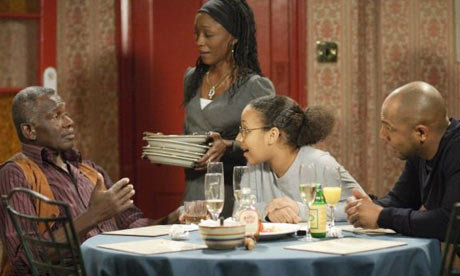(click to enlarge)
As part of my research and planning, I have created a small mood board to show the qualities of Mill Lane’s ideal audience member. The areas that I have covered are regionality, age, social class and ethnicity as they are the most relevant to our target audience.
(click to enlarge)
Regionality
Regionality is important as it allows the audience to understand the influences that a location can have on the characters of the soap. It also gratifies the audiences members' personal needs by allowing them to compare their lives to those of the characters'.
Because our soap is set in the countryside, our ideal audience member would live in a rural location. This means that our audience can relate to the hobbies, activties and lifestyle of the characters.
I've also decided that because our soap puts a modern spin on the traditional rural soap by including a young and inner-city character, our soap opera appeals to a wider range of audiences, including people who live in urban areas.
Age
Age is important as it allows the audience to relate directly to the characters in terms of morals, beliefs, experiences, interests and problems. It also gratifies the audiences members' personal needs by allowing them to compare their lives to those of the characters'.
Our ideal audience member would not have a certain age as our soap opera would appeal to a range of different age groups. Because the characters of Mill Lane range from sassy young females to bitter elderly residents, viewers of all ages are able to engage with the soap.
Families would be the most beneficial target audience group for our soap as the age range is likely to be quite broad, and could include as many as 3-4 generations. The reason we chose to target families over other audiences is because of their influences on each other.
If a family watches TV together in the evenings, then they are watching the same programme together. Therefore, if one member of the family watches our soap, then the other members of the family will also watch our soap.
Our ideal audience member would not have a certain age as our soap opera would appeal to a range of different age groups. Because the characters of Mill Lane range from sassy young females to bitter elderly residents, viewers of all ages are able to engage with the soap.
Families would be the most beneficial target audience group for our soap as the age range is likely to be quite broad, and could include as many as 3-4 generations. The reason we chose to target families over other audiences is because of their influences on each other.
If a family watches TV together in the evenings, then they are watching the same programme together. Therefore, if one member of the family watches our soap, then the other members of the family will also watch our soap.
Social Class
Social class is also an important factor of how well the audience connects with the soap. Because our soap opera has a broad range of characters, we are able to represent a variety of social classes. Ideally, out target audience would be fall under demographic groups B and under.
We intentionally excluded demographic group A as the differences in lifestyles between the viewer and the characters would be too extreme for a connection to even be established between the two. Our ideal target audience member would work during the day and relax in the evenings. This would means that watching our soap could be associated with relaxing at home, which could result in becoming an every day routine.
We intentionally excluded demographic group A as the differences in lifestyles between the viewer and the characters would be too extreme for a connection to even be established between the two. Our ideal target audience member would work during the day and relax in the evenings. This would means that watching our soap could be associated with relaxing at home, which could result in becoming an every day routine.
Ethnicity
In the story lines of Mill Lane, we intend to introduce new characters from different ethnic backgrounds. Because modern society is so culturally diverse, including characters of different religions, cultures and skin colours would reflect the reality of the world today and create a strong sense of verisimilitude.
It is also important to us that our soap includes a range of ethnicities as it means that our range of target audience members because much more broad, and allows people from other countries in the world to be able to relate to the characters and events in the soap.
It is also important to us that our soap includes a range of ethnicities as it means that our range of target audience members because much more broad, and allows people from other countries in the world to be able to relate to the characters and events in the soap.











